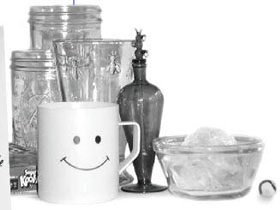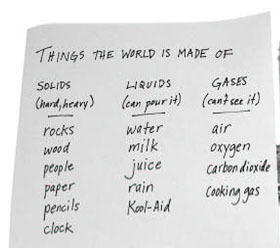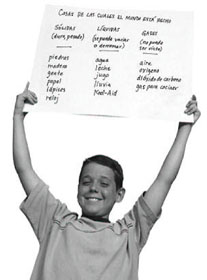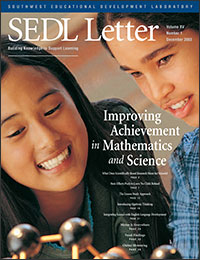Matter is Everywhere | Hay materia en todos lados
Finding ways to connect mathematics, science, and language to students' everyday lives is a challenge, especially for teachers whose students come from diverse cultural and linguistic backgrounds. And while many mathematics and science textbooks provide theoretical suggestions to connect activities to real life, the language component is missing for the most part.
SEDL's Integrating Mathematics, Science, and Language: An Instructional Program is a two volume curriculum and resources guide designed to help K–3 elementary school teachers organize instructional activities to increase the learning of Hispanic primary-grade children whose first language is not English. The guide offers a curriculum plan, instructional strategies and activities, suggested teacher and student materials, and assessment procedures.
The guide is made up of units that contain overview materials and background information for the teacher, the lessons, an annotated bibliography, and a list of reference and resource materials for teachers. Preceding each complete unit in English is a Spanish version of background information for the teacher and for parents to help support student learning at home. The lesson cycle is made up of five phases: encountering the idea, exploring the idea, getting the idea, organizing the idea, and applying the idea. Language development strategies specifically related to mathematics and science processes are also incorporated into the lessons.
The following is a condensed bilingual version of a lesson from Integrating Mathematics, Science, and Language: An Instructional Program. The lesson, Matter Is Everywhere, is taken from the Unit on Matter. Teachers who use this lesson in their classroom can use the Spanish version to engage Spanish-speaking parents in supporting their children's learning at home. For more information, visit SEDL's Web site at http://www.sedl.org/scimath/pasopartners/pdfs/matter.pdf
Sample Lesson
Matter Is Everywhere
Big Ideas: Everything that we see and touch is matter.
Whole Group Work
| Materials:
| Word tags:
|
Encountering the Idea
 Begin this overview lesson with a question: What is the world made of?
Begin this overview lesson with a question: What is the world made of?
Write students' ideas on a chalkboard for later use. If students do not mention air, ask if air should be on the list. What about water? What about our bodies? Ask students how some of these things are alike? Ask students what ice is.What is steam? Yes, both are water. Then ask, what is the difference between ice, water, and steam?
Exploring the Idea
Perfume
Open the perfume bottle, set it in an open space, and ask students, "Do you smell the perfume? Why can you smell the perfume if it is far away from you?" (Perfume is a liquid, but it has a smell; the smell is a vapor; a vapor is a gas; a gas can go all over the room; it doesn't stay in one place.)
Kool-Aid
Look at this cup of Kool-Aid. Is Kool-Aid matter? Is it solid or liquid? What shape is this liquid in? Now I'm going to pour it in different tumblers.What shape does it have? What can we say about a liquid? We can see it and feel it, but it doesn't have a definite shape.
Marble
Look at this marble. This is a solid. Describe it. (Hard, heavy, definite shape, can see it, feel it). What can we say about matter in the form of a solid?
Solids, Liquids, and Gases
Ask students to look around the room and list things that are either solid, liquid, or gas. Write them on a chart under the words: Solid, Liquid, or Gas.
Getting the Idea
 Tell students that everything we see and touch is matter. Our bodies are made of matter, the water we drink is made of matter, and so is the air around us. There is little we can see and feel that is not matter. Matter exists as a solid, a liquid, or a gas.
Tell students that everything we see and touch is matter. Our bodies are made of matter, the water we drink is made of matter, and so is the air around us. There is little we can see and feel that is not matter. Matter exists as a solid, a liquid, or a gas.
Organizing the Idea
Have students write about matter in their journals—what it looks like, what it feels like. Students may draw a picture of matter. Students may make a checklist of things to look for in matter to be able to say whether it is in solid, liquid, or gas form.
Applying the Idea
Problem solving
- What is Jello? A solid or a liquid? Can both answers be correct? Why?
- Is temperature related to the form that water is in? Explain.
- Do you think that the temperature of matter is related to whether it is in solid, liquid, or gas form? Why do you think that might be true?
For more activities from this lesson, consult SEDL's Web site at http://www.sedl.org/scimath/pasopartners/pdfs/matter.pdf
Lección modelo
Hay materia en todos lados
Ideas grandes: Todo lo que vemos y tocamos es materia.
Actividad en grupo
| Materiales:
| Palabras claves:
|
ENCONTRAR LA IDEA
Empiece este repaso con una pregunta: ¿De qué está compuesto el mundo?
Escriba las ideas de los estudiantes en el pizarrón. Si los estudiantes no mencionan aire, pregúnteles si aire deberá encontrarse en la lista. ¿Y el agua? ¿Y nuestros cuerpos? Pregúnteles a los alumnos qué hay de similar en estas dos cosas. Pregúnteles a los alumnos lo que es el hielo. ¿Qué es vapor? Sí. Ambos son agua. Luego pregunte lo que hay de diferencia entre el hielo, agua, y vapor.
EXPLORACIîN DE LA IDEA
 Perfume
Perfume
Abra la botella de perfume; colóquela en un espacio abierto y pregúnteles a los alumnos, "Huelen ustedes el perfume? ¿Cómo es que pueden oler el perfume si se encuentra tan lejos de ustedes?" (El perfume es un líquido, pero tiene un olor; el olor es un vapor; el vapor es un gas; un gas puede estar disperso por toda la habitación; no se queda en un solo lugar.)
Kool-Aid
Vean esta taza de Kool-Aid. ¿El Kool-Aid es materia? ¿Es sólido o líquido? ¿Qué forma tiene este líquido? Ahora, lo vertiré en varios recipientes. ¿Qué forma adquirió ahora? ¿Qué podemos concluir acerca de un líquido? Podemos verlo y sentirlo, pero no tiene forma definitiva.
Canica
Vean esta canica. Ésta es un sólido. Descríbenla. (Dura, pesada, forma definida, podemos verla, sentirla). ¿Qué podemos concluir acerca de materias sólidas?
Sólidos, Líquidos, y Gases
Pídales a los alumnos a que vean alrededor del salón y que identifiquen cosas que sean sólidas, líquidas, o gases. Escríbelas en una cartulina bajo las palabras: sólida, líquida, o gas.
COMPRENDER LA IDEA
Dígales a los alumnos que todo lo que vemos y tocamos es materia. Nuestros cuerpos están hechos de materia, el agua que bebemos está hecho de materia, al igual que todo el aire que nos rodea. Hay muy poco de lo que podemos ver y sentir que no sea materia. La materia existe como sólido, líquido, o gas.
ORGANIZAR LA IDEA
Pídales a los alumnos que escriban acerca de la materia en sus diarios. ¿Qué características tiene la materia? Los alumnos podrían dibujar algunos ejemplos de materia. Además, podrían escribir una lista de características de la materia para determinar si su forma es sólida, líquida o gas.
APLICAR LA IDEA
Resolución de problemas 1. ¿Qué es la gelatina, un sólido o líquido? ¿Podrían estar correctas las dos respuestas? ¿Por qué? 2. ¿Tiene que ver la temperatura ambiente con la forma en que se encuentra el agua? Explique. 3. ¿Crees tú que la temperatura ambiente afecta la forma en que toma la materia, ya sea que ésta se encuentre en forma de sólido, líquido, o gas? ¿A qué se debe esto? Para más actividades para esta lección, consulte el sitio electrónico de SEDL http://www.sedl.org/scimath/pasopartners/pdfs/tmatter.pdf
Next Article: Fossil Findings: Research in the Field Leads to Changes in the Classroom

